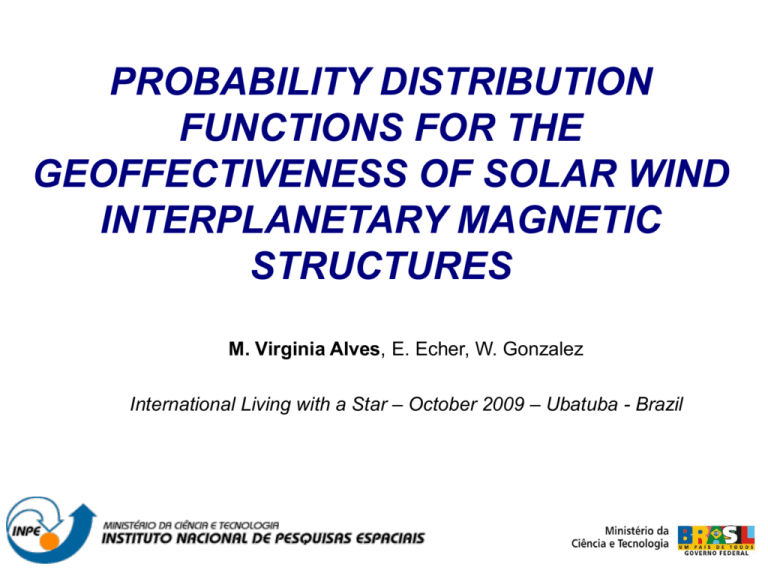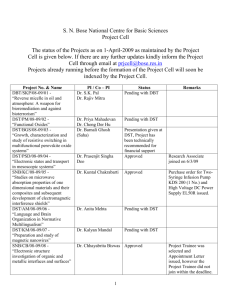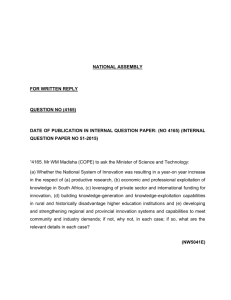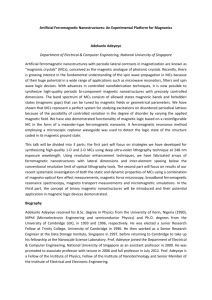Probability distribution functions for the geoffectiveness of
advertisement

PROBABILITY DISTRIBUTION FUNCTIONS FOR THE GEOFFECTIVENESS OF SOLAR WIND INTERPLANETARY MAGNETIC STRUCTURES M. Virginia Alves, E. Echer, W. Gonzalez International Living with a Star – October 2009 – Ubatuba - Brazil Solar wind interplanetary magnetic structures Early 1930s – intense magnetic storms - driven by interplanetary plasma structures Interplanetary structures can be geoeffective (cause intense magnetic storms) if they present a continuous, long-duration, and intense southward magnetic field 3 main interplanetary structures are found in interplanetary space: ICMEs – interplanetary manifestations of CMEs (including MCs), interplanetary shocks, and corotating interaction regions (CIR). Structure Properties - CIR proton density rises to unusually high values near the leading edges of the streams; persist for ~1 day; density profile - in the inverse ratio to bulk speed (V) ; IMF magnitude - proportional to V constant polarity throughout the stream except for some fluctuations lasting a few hours; proton temperature (T) varies in a pattern similar to V; it increases with speed and shows a slight decrease during the magnetic field descent phase. Shocks and CIRs February/March 1999 SI = stream interface (contact between fast and slow SW) Structure Properties - ICMEs Common characteristics at 1 AU: abnormally low proton temperature reduction in the level of the IMF fluctuations some degree of organization in the magnetic field bounded by distinct magnetic field discontinuities (abrupt changes in plasma parameters) Magnetic Clouds (subset of ICMEs) large-scale smooth field rotation enhanced magnetic field magnitude decreased plasma temperature (low - ratio between thermal and magnetic pressure) Complex Ejecta (CE) Burlaga et al, 2001 - fast (>600km/s) flows that are neither corotating flows nor MCs - move past Earth during a day or more - present disordered magnetic fields; Some CE - consist of material and magnetic fields from multiple CMEs. ICMEs and Schocks Previous Results Gosling et al (1991) - Kp 191 MCs, 171 shocks, 1978-1982, 44% (ICMEs) and 53% (shocks) Kp 5Jurac et al (2002) – Dst 107 shocks, 1995-2000, 21% Dst -100 nT, 40% shocks, 10-15% non shocks Wu & Lepping, (2002) Dst 34 MCs, 1995-1998, 88% Dst -50 nT Zhang et al., (2004) Dst 104 MCs, 1998-2002, 80% Dst -30 nT, 56% Dst -50 nT, and 34% Dst -100 nT Huttunen et al., (2005) Dst 74 MCs, 1997-2003, ~71% Dst -50 nT Yermolaev et al. [2005] review - addressed a comparison of data analysis methods Zhang et al., 2007 1996-2000 identified the solar CME sources for 27 major geomagnetic storms (Dst -100 nT), only 1 caused by CIR Gopalswamy (2008) Solar cycle 23 summarized the properties of CMEs and high-speed streams and described their geoffectiveness Events Observation Period: 1964-2003 MCs: 170 CIRs: 727 Interplanetary Schocks: 830 eventos Metodology: geoeffectivity is analized in terms of geomagnetic indices Kp (ap), AE e Dst; peak values were obtained within two days after the observation of a given interplanetary magnetic structure. Intense Moderate Weak Quiet Dst Dst ≤ -100 -50≤ Dst <-100 -30 ≤ Dst < -50 Dst > -30 Kp Kp ≥ 7o ap ≥ 111 5+ ≤ Kp < 7o 56 ≤ ap < 111 4+ ≤ Kp < 5+ 32 ≤ ap < 56 Kp < 4+ ap < 32 AE (nT) AE ≥ 1000 500 ≤ AE < 1000 200 ≤ AE < 500 AE < 200 General Statistical Results Echer et al. Space Weather, 2006 Influence of MCs on shock geoeffectiveness Echer et al. Space Weather, 2006 Distribution of the magnetic indices MC SHOCK CIR 25 15 15 10 10 5 5 % events 20 15 10 5 0 -100 0 100 300 400 500 -Dst 10 % events 200 0 -100 0 100 300 400 500 -Dst 10 5 200 500 1000 1500 2000 2500 3000 100 300 400 500 -Dst 0 0 500 AE 1000 1500 2000 2500 3000 0 500 AE 25 200 5 0 0 0 10 5 0 0 -100 1000 1500 2000 2500 3000 AE 15 15 10 10 5 5 % events 20 15 10 5 0 0 0 100 200 ap 300 400 0 0 100 200 ap 300 400 0 100 200 ap 300 400 Results from normality W-test Shapiro-Wilk (Royston, 1981) • MC and CIR - Dst and ap are not normally distributed at 0.05 significance level;AE is normally distributed at 0.05 significance level; • Shocks, AE is not normally distributed at 0.05; removing the extreme values, the distribution becomes Gaussian at 0.05 Wtest; • The parameter A3 is the asymmetry; it indicates how different of a normal distribution, in terms of extremes, a distribution is (A3 = 0 for a normal distribution). Dst Shocks Average -71.9 sd 62.7 min -472 max 10 Median -55 A3 -2.05 N 830 Dst MCs -94.7 54.4 -288 -5 -82 -1.07 170 Dst CIRs -43.2 24.2 -131 9 -38 -0.85 747 AE Shocks 870 396 106 2780 840 0.72 830 AE MCs 1007 344 104 2155 1014 0.34 170 AE CIRs 792 280 116 2300 786 0.50 747 ap Shocks 72.3 67 3 400 48 1.88 830 ap MCs 92 63 7 300 80 0.87 170 ap CIRs 48 29 9 236 39 1.50 747 Fitted distribution functions 0,15 0,10 0,05 0,00 -50 0 50 100 150 200 250 300 350 400 450 500 -Dst 0,100 Probability Gaussian for Dst and AE Probability 0,20 Probability Distribution Function – fitting 0,075 0,050 0,025 0,000 0 500 1000 1500 Probability 2000 2500 AE 0,15 Exponential for ap Shocks MCs CIRs 0,10 0,05 0,00 0 100 200 300 ap 400 3000 Conclusions Transient interplanetary structures are more geoeffective than CIRs MCs are the most geoeffective structure as measured by the three geomagnetic indices used here The geoeffectiveness as measured by the AE index is the largest one for all the interplanetary structures we used in this paper The main geoeffectiveness of CIRs is seen in AE activity, while for shocks and MCs the Dst and Kp geoeffectiveness is much higher relatively to CIRs The occurrence of combined structures (Shock + MC) seems to be more geoeffective for every class of geomagnetic activity than the occurrence of isolated interplanetary structures The probability distributions obtained in this work can be used for space weather forecast by given a probability of an observed interplanetary solar wind magnetic structure be followed by every type of magnetic activity. References 1. ECHER, Ezequiel ; GONZALEZ, Walter D ; ALVES, M. V. Minimum variance analysis of interplanetary coronal mass ejections around solar cycle 23 Maximum (1998-2002). Solar Physics, 233 (2), 249-263, 2006 2. ALVES, M. V.; ECHER, Ezequiel ; GONZALEZ, Walter D . Geoeffectiveness of Corotating interaction regions as measured by Dst index (A07S05, doi:10.1029/2005JA011379.). J. Geophys. Research, 111 (5), 1-9, 2006 3. ECHER, Ezequiel ; GONZALEZ, Walter D ; ALVES, M. V. On the geomagnetic effects of solar wind interplanetary magnetic structures (S06001, doi:10.1029/2005SW000200). Space Weather The International Journal of Research And Applications, 4, 1-11, 2006 4. ECHER, Ezequiel ; ALVES, M. V. ; GONZALEZ, Walter D . A statistical study of magnetic cloud parameters and geoeffectiveness. J. of Atmospheric and Solar-Terrestrial Physics, 67 (10), 839-852, 2005 5. ECHER, Ezequiel ; ALVES, M. V. ; GONZALEZ, Walter D . Geoeffectiveness of interplanetary shocks during solar minimum (19951996) and solar maximum (2002). Solar Physics, 221, 361-380, 2004 Acknowledgements: ACE SWEPAM and MAG teams - data publicly available; NSSDC at Goddard Space Flight Center – OMNIweb database; National Geophysical Data Center and to the World Data CenterGeomagnetism – geomagnetic indices. Brazilian Agency CNPq.





